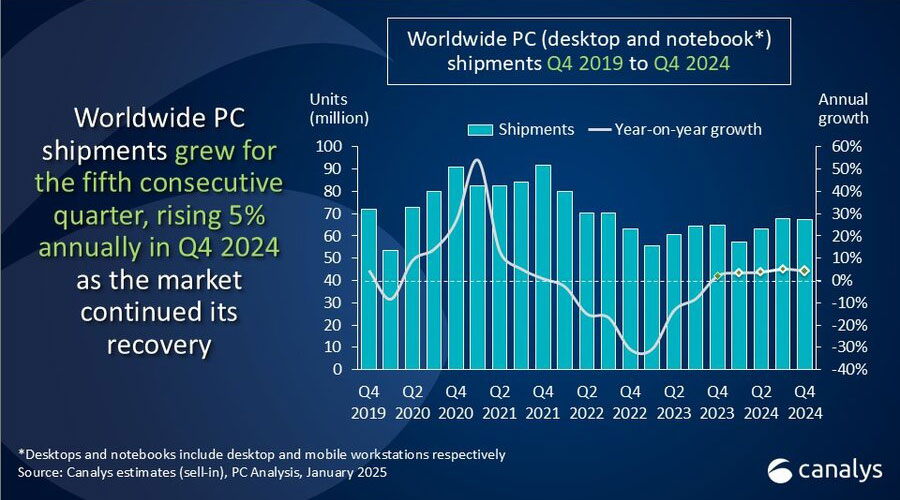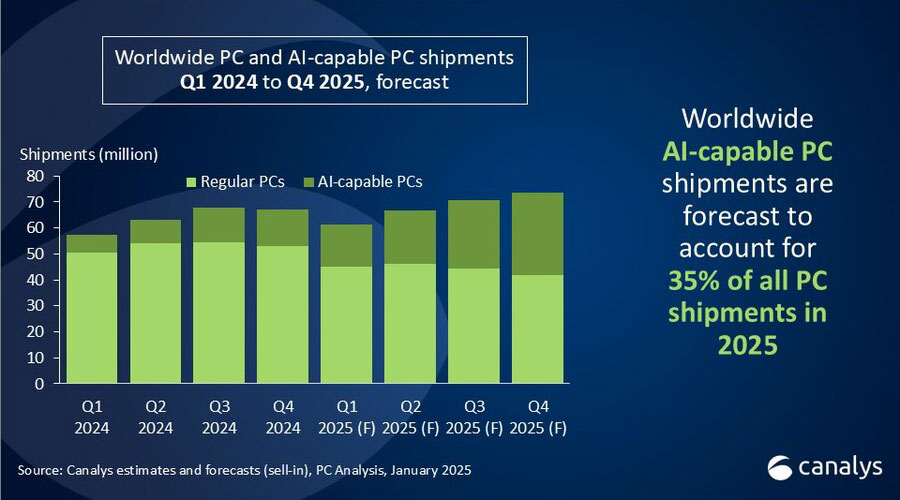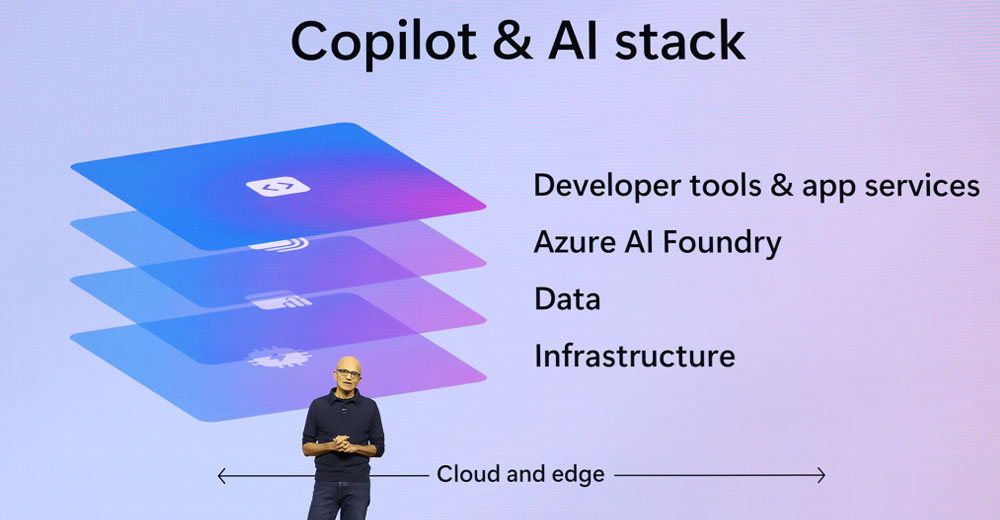Shipments of personal computers grew in 2024, fueled by businesses replacing old hardware and Microsoft’s looming end of support for its Windows 10 operating system.
According to market research firm Canalys, PC shipments climbed 3.8% in 2024 to 255.5 million units from 246.3 million in 2023. IDC, another research firm, pegged 2024 shipments higher — 262.7 million — but it also had higher 2023 shipments — 260.2 million, for a year-over-year increase of 1%.
“2024 was a year of modest recovery and a return to traditional seasonality for the PC market as full-year shipments grew 3.8%,” Canalys Analyst Kieren Jessop said in a statement.
“Growth increased slightly in Q4, with shipments rising by 4.6% year on year, signaling a positive trend as we moved to within a year of the Windows 10 end-of-support date,” he continued.
“Holiday season demand was supported by strong discounting by vendors and retailers, enticing consumers who have become increasingly price-sensitive,” he stated.
Jessop noted that the use of buy now, pay later services supported that trend, with increasing examples of those offerings being leveraged to drive spending on big-ticket items, such as PCs.
Meanwhile, he added that in China, government stimulus in the form of consumer subsidies helped to promote spending on notebooks amid a weakening demand environment.
Strong Seasonal Sales
“Though the market has been experiencing a slower return to growth, there was some room for optimism in Q4 as government subsidies in China led to better than expected performance within the consumer segment,” IDC’s Worldwide Mobile Device Trackers Research Manager Jitesh Ubrani said in a statement.
“Beyond that,” he continued, “the U.S. and some European countries also showed strong performance due to end-of-year sale promotions, as well as enterprises continuing on the path of upgrading hardware before the end of support for Windows 10, which is scheduled for October 2025.”

“Year-end sales were a little bit more aggressive than we’ve seen in recent years,” added IDC Program Vice President for Worldwide Mobile Device Trackers Ryan Reith.
Much of the promotional activity in the PC space throughout 2024 was aimed at moving inventory, he noted. “PC makers wanted to keep things moving, even if it meant smaller margins because getting people on new hardware means other opportunities like selling them new software,” he told TechNewsWorld.
Commercial shipments, representing about 50% of the global PC market, were also an important part of the growth story. “Companies refresh their PCs at a pretty stingy cadence,” Reith said. “Usually, it’s between three and four years in most of the developed markets. It can go a little bit longer in developing markets. But the reason they do that is not because the hardware isn’t good. It’s usually because of the software.”
“Businesses can only go so long before they refresh. You’re not gonna keep a PC for 10 years in a business,” added Jack E. Gold, founder and principal analyst with J.Gold Associates, an IT advisory company in Northborough, Mass.
“Covid brought in a ton of new machines three, three and a half, years ago,” he told TechNewsWorld. “Most companies refresh on a three-year basis. So we’re gonna see an uptick in business buying of PCs.”
End of Days for Win10
Jessop added that a significant factor contributing to PC shipment growth in 2024, which will continue in 2025, is the size and age of the installed hardware base. “It’s never been larger or older than now,” he told TechNewsWorld.
That’s why Canalys forecasts that commercial PC shipments will continue to outgrow consumer shipments. “Consumer price sensitivity and budget prioritization mean many people are delaying their next purchase,” Jessop explained.
Another factor stoking PC shipments is Microsoft’s announcement that it will stop supporting Windows 10 in October 2025. “Hundreds of millions of those old PCs are ineligible to update to Windows 11, so businesses will be nudged toward refreshing their devices,” Jessop said.
“Microsoft is getting increasingly aggressive in letting customers know that support is going to be ending, and they really need to upgrade to Windows 11,” added Ross Rubin, the principal analyst with Reticle Research, a consumer technology advisory firm in New York City.
“Given the relatively stringent requirements for that, the only way to do so is to purchase a new computer,” he told TechNewsWorld.
AI PCs Puzzle Consumers
Jessop cited the introduction of AI PCs into the market as an influencer of growth. “They’re being positioned as a halo category and are being used to open the door to conversations around a wider fleet refresh,” he said.
Paul Schell, an industry analyst with global technology intelligence firm ABI Research, sees AI PCs as having a significant impact on growth. “We continue to see the introduction of AI PCs, and in particular notebooks/laptops, as being the driving force behind a shortening of refresh cycles,” he told TechNewsWorld.
“In the AI PC segment, challenger Qualcomm has expanded its portfolio to include fewer premium chipsets — including an SKU targeting the $600 laptop range — which has a democratizing effect, as the first releases from all vendors, including Apple, Intel and AMD, were more premium,” he said.
Jessop, though, noted that despite the hype around the PCs at CES last week, the computers have failed to generate much excitement among buyers. “Many channel partners we surveyed indicated that their customers are either unaware of Copilot+ PCs or are unwilling to pay a premium price for them, even if they are aware,” he noted.
“This dual challenge limits the ability of the category to create a strong aspirational pull or halo effect,” he continued. “Customers are prioritizing pricing over perceived innovation, suggesting the value proposition for Copilot+ PCs needs stronger articulation or refining.”
AI PCs will be a big deal in 2025, contended Mark N. Vena, president and principal analyst with SmartTech Research in Las Vegas. “With special chips called NPUs [Neural Processing Units], they’re great for tasks like AI, language processing, and predicting things,” he told TechNewsWorld. “Businesses and people will want PCs that can use AI to make their work easier, more creative, and more automated.”

“I’m not convinced — yet — that AI will be a dominating factor, but as AI usage models become more compelling, AI PCs will become more attractive to the average mainstream user,” he said.
Eric Compton, director of technology equity research at Morningstar Research Services in Chicago, maintained that 2025 will be the same as 2024 in terms of fueling growth in PC shipments.
“The continued PC refresh cycle and the need to replace machines purchased during the boom years of 2020 and 2021 will be the primary factors,” he told TechNewsWorld. “If AI PCs can improve their functionality and generate some more unique demand, this could be a wildcard for additional demand.”














